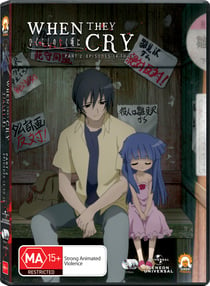Review
by Mark Sombillo,When They Cry - Part 2
| Synopsis: |  |
||
Almost like being in a time loop, stories of the town of Hinamizawa revolving around Keiichi and the mysterious curse of the village deity were told again and again in the first volume. Whichever version it was, all of them pointed to sinister ends and almost always unanswered questions. Now we are faced with the answers and reasons as more stories surrounding the deaths and intrigue of the past and the future too, are told to shed light into this mystery. Maybe in the end they'll generate more questions than answers but one way or another, the curse of Oyashiro-sama is more powerful than you can imagine. |
|||
| Review: | |||
Well now, predictably enough I've been given the task of reviewing the second part to Siren Visual's release of When They Cry, but contrary to my statement about the first volume, I've actually done this voluntarily. The first half of this series confronted audiences with disturbing, near sadistic tales about the town of Hinamizawa and how this affected the main protagonist Keiichi. It resulted anywhere from him committing suicide in the most ghastly of ways, to surviving the eradication of the whole town in an apparent accident. Whichever way it ended, each of these arcs finished off with lots of loose ends left dangling. This was what prompted me to once again put my hand up when we received the second half from the good people of Siren Visual. As much as the confronting story and visuals were very exhausting to go through in the first instalment, I'm generally not one of those people who walk out of a bad movie in the cinemas; I'm always of the belief that one way or another, there has got to be a satisfying end. In a way this volume has provided this conclusion and at the very least, I can't say that I regret taking it on after all.
What's immediately noticeable when you pop in the first DVD is the lack of Keiichi or even any mention of him. The first story arc is of an investigator looking into the kidnapping of the son of a minister. It happens right at the history of the mysterious deaths attributed to Oyashiro-sama. After some research, I later learn that this was the fourth and final of the “question arcs” but though this may seem out of place given that the first DVD volume was where all these question arcs were presented, because it was set back all the way from the dam protests, it was actually an effective way to highlight what this part of the series was going to be about; answers. The next lot of stories focus on different points of view that shed the previous arcs in a different light, giving rationale to the killings. Though the supernatural element of the curse was never fully discarded, these arcs have at least put events into context. There's still a good deal of requirement for the audience to make up their own minds about what it all means, but at least you can walk away knowing that you didn't waste your time. In fact as the last episode ends in an almost mirrored Groundhog Day manner, it all comes together as if all the different story arcs were actually not completely distinct tales at all.
Voice acting and characterisations remain quite strong, both in English and Japanese. There are moments when the super-deformed art styles continue to fail in delivering good quality or even consistent character designs. It's the kind of mediocre quality you get during lulls and filler episodes of ongoing series like Bleach. Background artwork is a bit more on the noteworthy side. Box design for the release is eye catching despite its muted palette; there's a sense of both eeriness and solitude emanating from it that makes you just want to pick it up. Now that I've completed watching this from start to finish, what conclusion can I derive from it? Another series that comes to mind which had a similarly all-over-the-place presentation was The Melancholy of Haruhi Suzumiya, and I have to say, when done correctly, this method keeps things fresh and progressive. Done improperly however and all you'll get is a lot of confusion. The fact that each arc, though distinct in terms of story, often incorporate some elements from each other means that it's very easy to lose track of what is actually going on altogether.
To figure this all out I've had to do fair bit more research than I normally would for my reviews. I've had to read up on the original games and other sources and then actually try to arrange it in a spreadsheet so that I can visualise how the arcs interconnect. This seems more laborious than you'd normally expect for watching an anime but rather than see this as a bad thing I must finally concede, When They Cry has reached the most unique status of being an urban legend. It engages you beyond the show itself, bringing out the inner detective in all of us and makes you try to piece it together. And just like any good urban legend, we will never fully know exactly what happened in the quiet town of Hinamizawa. |
| Grade: | |||
|
Overall (dub) : B
Overall (sub) : B
Story : B+
Animation : C-
Art : C-
Music : B
+ Intriguing story that will make you want to solve it. ⚠ Lots of blood and gore. |
|||
| Production Info: | ||
|
Full encyclopedia details about Release information about |
||





